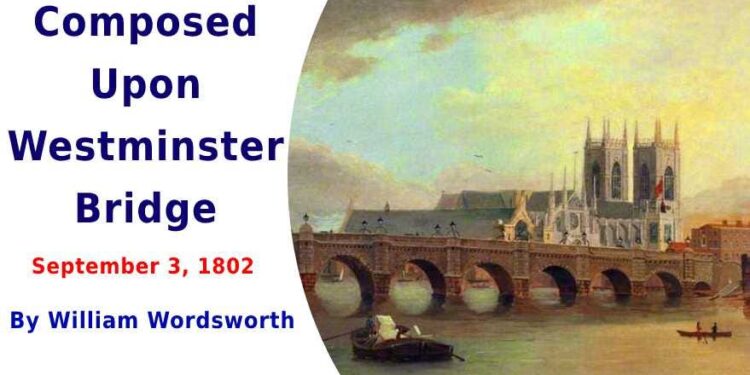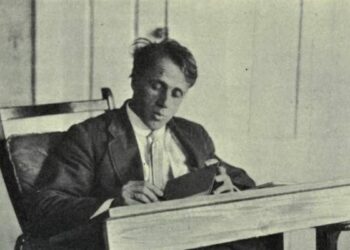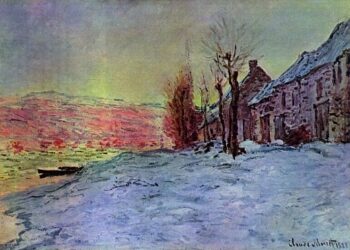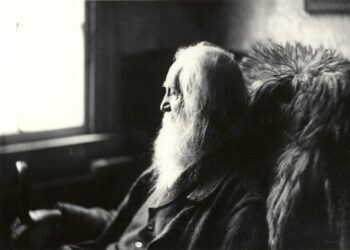Introduction
Composed upon Westminster Bridge By William Wordsworth William Wordsworth, one of the most prominent figures of the Romantic era, penned “Composed upon Westminster Bridge, September 3, 1802” as a reflection on the profound beauty of the city of London at dawn. Written in a time of significant change and upheaval, both in the natural world and in the realm of human experience, this poem encapsulates Wordsworth’s deep appreciation for nature, his connection to urban life, and the interplay between human emotions and the natural environment.
This poem is not only a celebration of the beauty of London but also a meditation on the relationship between humanity and the urban landscape. Wordsworth’s work invites readers to reflect on the essence of nature, the serenity found within the bustling city, and the transient moments of beauty that can easily go unnoticed in daily life.Composed upon Westminster Bridge By William Wordsworth
Summary of the Poem
Structure and Form
“Composed upon Westminster Bridge” consists of a single stanza of 14 lines, following the structure of a Petrarchan sonnet, characterized by its iambic pentameter. The rhyme scheme (ABBAABBA CDCDCD) enhances the lyrical quality of the poem, allowing Wordsworth to convey both emotion and thought in a compact form. This form is fitting for a poem that captures a moment of beauty and reflection.
READ MORE
Summary
The poem opens with an expression of awe at the stillness of London in the early morning. Wordsworth describes the city as it lies “silent, bare,” capturing a sense of tranquility that is often absent in the hustle and bustle of daily life. The speaker’s observations reveal a city that appears almost ethereal, bathed in the soft light of dawn. The morning sun illuminates the buildings, making the entire scene appear majestic and beautiful.Composed upon Westminster Bridge By William Wordsworth
As Wordsworth gazes upon the city, he becomes aware of its inherent beauty. He reflects on the harmony of nature and humanity, suggesting that even within an urban environment, moments of natural beauty persist. The imagery he employs evokes a sense of calm and wonder, as he contrasts the peacefulness of the morning with the often chaotic nature of urban life. He sees the city not merely as a human construction but as an integral part of the natural world.
The poet then delves deeper into the emotional and spiritual dimensions of his experience. He acknowledges the grandeur of the architecture, particularly the iconic structures of London, yet it is the natural beauty of the morning light that captivates him the most. He expresses a sense of gratitude and reverence for the scene before him, conveying how this moment impacts his perception of the city and of life itself.Composed upon Westminster Bridge By William Wordsworth

Themes
1. The Beauty of Nature and Urban Life
A central theme of the poem is the beauty found in both nature and urban life. Wordsworth emphasizes the harmony between the two, illustrating that even in a bustling metropolis like London, moments of serene beauty can emerge. This theme is particularly resonant given the Industrial Revolution’s impact on urban life at the time, when nature often seemed to be overshadowed by human advancement.
2. Transience and Permanence
The poem also explores the transient nature of beauty. Wordsworth captures a fleeting moment—dawn in London—that will quickly pass. This idea is juxtaposed against the permanence of the city’s structures, highlighting the contrast between the ephemeral experiences of life and the enduring nature of the urban landscape. The poet invites readers to appreciate these transient moments of beauty, suggesting that they hold significant meaning.Composed upon Westminster Bridge By William Wordsworth
READ MORE
3. Reflection and Spirituality
Another theme is the contemplative and spiritual quality of the experience. Wordsworth’s reflections reveal a deep connection to the landscape before him, suggesting that moments of beauty can lead to profound insights about life and existence. The peacefulness of the morning prompts introspection, allowing the poet to engage with his thoughts and emotions on a deeper level.Composed upon Westminster Bridge By William WordsworthComposed upon Westminster Bridge By William Wordsworth
Imagery and Symbolism
Wordsworth employs rich imagery and symbolism throughout the poem, enhancing its emotional depth and resonant themes.
- Morning Light: The dawn symbolizes new beginnings, purity, and the promise of a new day. The gentle light illuminating the city suggests hope and renewal, reinforcing the idea that beauty can be found even in the most unexpected places.
- The City: London itself serves as a symbol of human achievement and progress, yet Wordsworth portrays it as intertwined with the natural world. The description of the city as “silent” and “bare” evokes a sense of tranquility, suggesting that it, too, is deserving of reverence and appreciation.
- Nature and Humanity: The interplay between nature and humanity is a recurring motif in Wordsworth’s poetry. In this poem, the connection is emphasized through the harmonious coexistence of the city’s architecture and the natural beauty of the dawn, illustrating how both elements can enhance and enrich one another.Composed upon Westminster Bridge By William Wordsworth
Analysis of Language and Style
Wordsworth’s use of language in “Composed upon Westminster Bridge” is marked by its simplicity and clarity, characteristics often associated with the Romantic movement. The poet employs vivid imagery and sensory details to immerse the reader in the scene, creating a palpable sense of place.Composed upon Westminster Bridge By William Wordsworth
Diction and Tone
The tone of the poem is one of awe and reverence. Wordsworth’s choice of words conveys his admiration for the beauty of the city at dawn. Phrases such as “the beauty of the morning” and “the city now doth, like a garment, wear” reflect a tone of appreciation and wonder. This diction elevates the poem, transforming a simple observation into a profound experience.Composed upon Westminster Bridge By William Wordsworth
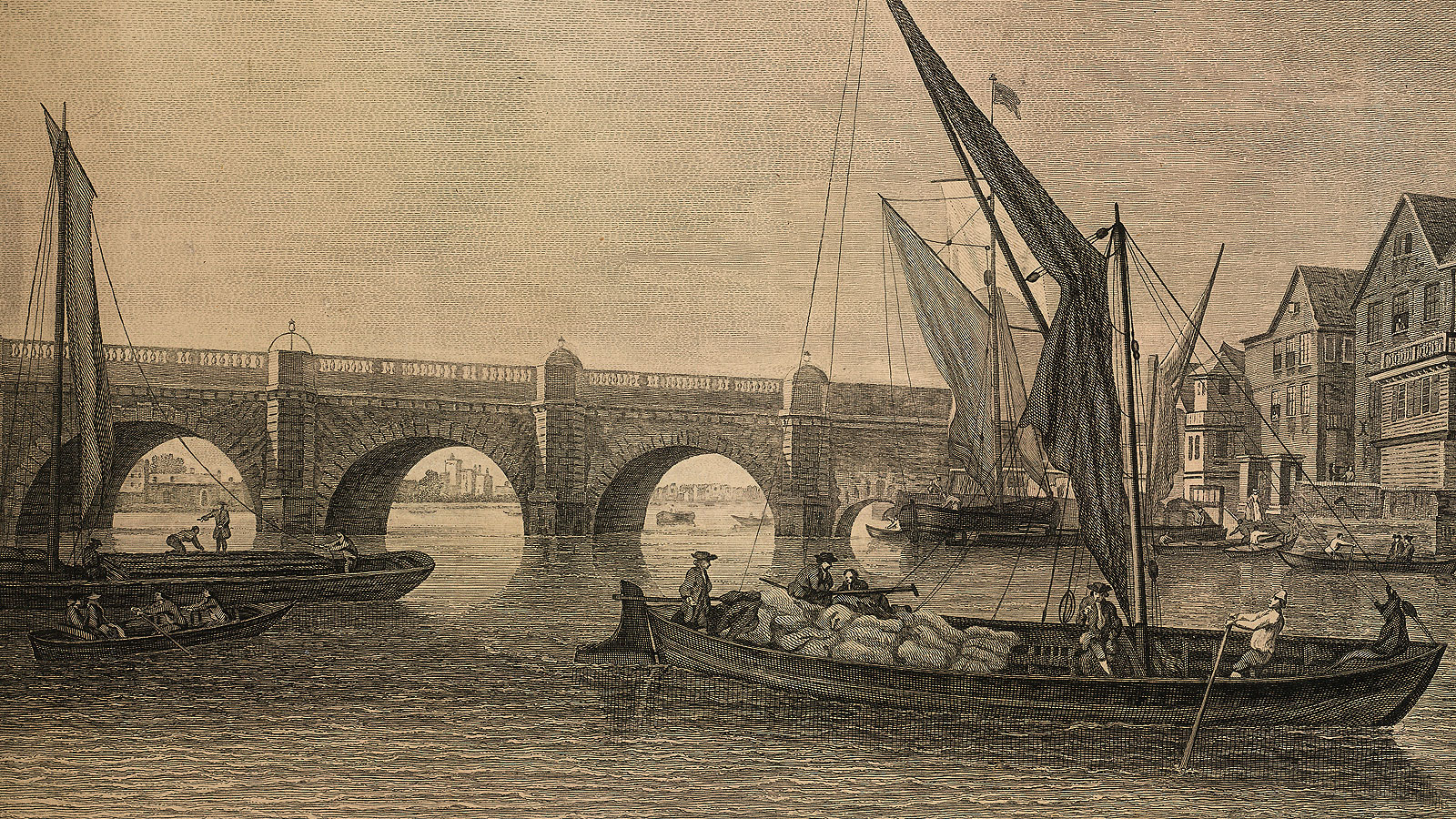
Use of Personification
Wordsworth often personifies elements of nature, giving them human-like qualities that deepen the emotional impact of the poem. For instance, the city is described as wearing the morning light “like a garment,” suggesting a sense of intimacy and connection between the city and its environment. This personification emphasizes the relationship between humanity and nature, highlighting how both exist in a shared space.
Contrast and Juxtaposition
The poem also utilizes contrast effectively. Wordsworth juxtaposes the stillness of the morning with the bustling life typically associated with London. This contrast serves to heighten the beauty of the moment, illustrating how tranquility can exist within a chaotic environment. The imagery of the city at dawn stands in stark relief to the usual hustle and bustle of urban life, inviting readers to reconsider their perceptions of both the city and the natural world.
READ MORE
Conclusion
“Composed upon Westminster Bridge, September 3, 1802” is a remarkable reflection on the beauty of London and the interplay between nature and urban life. Through vivid imagery, rich symbolism, and thoughtful contemplation, Wordsworth invites readers to appreciate the fleeting moments of beauty that can be found in everyday life.
The poem serves as a testament to the enduring power of nature, even within the confines of a city. It encourages a deeper connection to our surroundings, prompting reflection on the relationship between humanity and the environment. Wordsworth’s celebration of the beauty of the world resonates powerfully, reminding us to pause and appreciate the fleeting moments that enrich our lives.
(FAQ)
1. What is the main theme of “Composed upon Westminster Bridge”?
The main theme revolves around the beauty of nature and urban life, exploring the harmony between the two. The poem emphasizes the transient nature of beauty and the contemplative insights it can inspire.
2. What is the significance of the setting in the poem?
The poem is set in London at dawn, a time when the city is typically quiet and serene. This setting allows Wordsworth to capture a moment of beauty that contrasts with the usual chaos of urban life, highlighting the peaceful coexistence of nature and humanity.
3. How does Wordsworth use imagery in the poem?
Wordsworth employs vivid imagery to immerse readers in the scene, using descriptive language to evoke the beauty of the morning light and the cityscape. This imagery enhances the emotional depth of the poem, allowing readers to experience the moment alongside the speaker.
4. What does the poem say about the relationship between nature and humanity?
The poem suggests that nature and humanity are interconnected, with moments of natural beauty existing even within urban environments. Wordsworth emphasizes that both elements can enhance and enrich one another, encouraging a deeper appreciation of the world around us.
5. How does the tone of the poem contribute to its meaning?
The tone of awe and reverence in the poem elevates the experience of the speaker, transforming a simple observation into a profound moment of reflection. This tone encourages readers to share in the speaker’s appreciation for the beauty of the dawn and the city.
6. What literary devices are used in the poem?
Wordsworth employs various literary devices, including personification, contrast, and vivid imagery. These devices enhance the emotional impact of the poem and allow for a deeper exploration of its themes.
7. How does the poem reflect Romantic ideals?
The poem reflects Romantic ideals through its emphasis on emotion, nature, and individual experience. Wordsworth’s appreciation for the beauty of the natural world and the introspective quality of the poem align with key themes of the Romantic movement.
8. Why is the title significant?
The title “Composed upon Westminster Bridge, September 3, 1802” provides context for the poem, indicating both the specific location and the moment in time that inspired the reflection. The date suggests a historical context, while the location ties the poem to a significant urban landscape.
READ MORE

